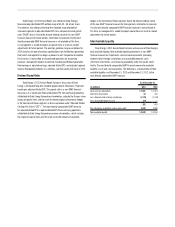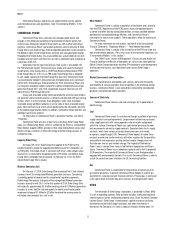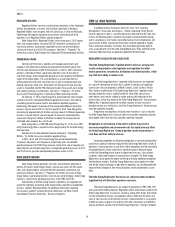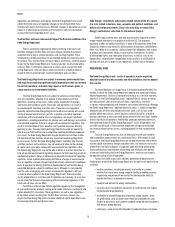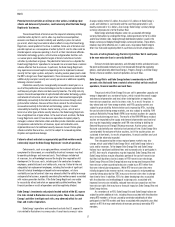Duke Energy 2013 Annual Report Download - page 27
Download and view the complete annual report
Please find page 27 of the 2013 Duke Energy annual report below. You can navigate through the pages in the report by either clicking on the pages listed below, or by using the keyword search tool below to find specific information within the annual report.
PART I
9
sufficient to provide storage space for spent fuel through the expiration of the
operating licenses, including any license renewals, for all sites except Shearon
Harris Nuclear Station (Harris) and Crystal River Unit 3. Under current regulatory
guidelines, Harris has sufficient storage capacity in its spent fuel pools through
the expiration of its renewed operating license. Crystal River Unit 3 was retired
in 2013, with plans to place the facility in SAFSTOR (extended storage) prior to
final decommissioning. An on-site dry cask storage facility will be installed to
accommodate storage of all spent nuclear fuel until the DOE accepts the spent
nuclear fuel.
The nuclear power industry faces uncertainties with respect to the cost
and long-term availability of disposal sites for spent nuclear fuel and other
radioactive waste, compliance with changing regulatory requirements, capital
outlays for modifications and new plant construction, the technological and
financial aspects of decommissioning plants at the end of their licensed lives,
and requirements relating to nuclear insurance. Nuclear units are periodically
removed from service to accommodate normal refueling and maintenance
outages, repairs, uprates and certain other modifications.
Regulated Utilities is subject to the jurisdiction of the NRC for the design, construction and operation of its nuclear generating facilities. The following table
includes the current expiration of nuclear operating licenses.
Unit Year of Expiration
Duke Energy Carolinas
Catawba Unit 1 2043
Catawba Unit 2 2043
McGuire Unit 1 2041
McGuire Unit 2 2043
Oconee Unit 1 2033
Oconee Unit 2 2033
Oconee Unit 3 2034
Duke Energy Progress
Brunswick Unit 1 2036
Brunswick Unit 2 2034
Harris 2046
Robinson 2030
Duke Energy Florida
Crystal River Unit 3(a) 2016
(a) Duke Energy Florida has requested the NRC terminate the Crystal River Unit 3 operating license as a result of the retirement of the unit.
The NRC issues orders with regard to security at nuclear plants in
response to new or emerging threats. The most recent orders include additional
restrictions on nuclear plant access, increased security measures at nuclear
facilities and closer coordination with intelligence, military, law enforcement
and emergency response functions at the federal, state and local levels. As the
NRC, other governmental entities and the industry continue to consider security
issues, it is possible that more extensive security plans could be required.
Regulation
State
The NCUC, PSCSC, FPSC, PUCO, IURC and KPSC (collectively, the state
utility commissions) approve rates for retail electric and gas service within their
respective states. The state utility commissions, except for the PUCO, also have
authority over the construction and operation of Regulated Utilities’ generating
facilities. Certificates of Public Convenience and Necessity (CPCN) issued by
the state utility commissions, as applicable, authorize Regulated Utilities to
construct and operate its electric facilities, and to sell electricity to retail and
wholesale customers. Prior approval from the relevant state utility commission
is required for Regulated Utilities to issue securities. The underlying concept
of utility ratemaking is to set rates at a level that allows the utility to collect
revenues equal to its cost of providing service plus earn a reasonable rate of
return on its invested capital, including equity.
Each of the state utility commissions allows recovery of certain costs
through various cost-recovery clauses, to the extent the respective commission
determines in periodic hearings that such costs, including any past over or
under-recovered costs, are prudent. The clauses are in addition to approved
base rates.
Fuel, fuel-related costs and certain purchased power costs are eligible for
recovery by Regulated Utilities. Regulated Utilities uses coal, oil, hydroelectric,
natural gas and nuclear fuel to generate electricity, thereby maintaining a diverse
fuel mix that helps mitigate the impact of cost increases in any one fuel. Due
to the associated regulatory treatment and the method allowed for recovery,
changes in fuel costs from year to year have no material impact on operating
results of Regulated Utilities, unless a commission finds a portion of such costs
to have been imprudent. However, delays between the expenditure for fuel costs
and recovery from ratepayers can adversely impact the timing of cash flows of
Regulated Utilities.



